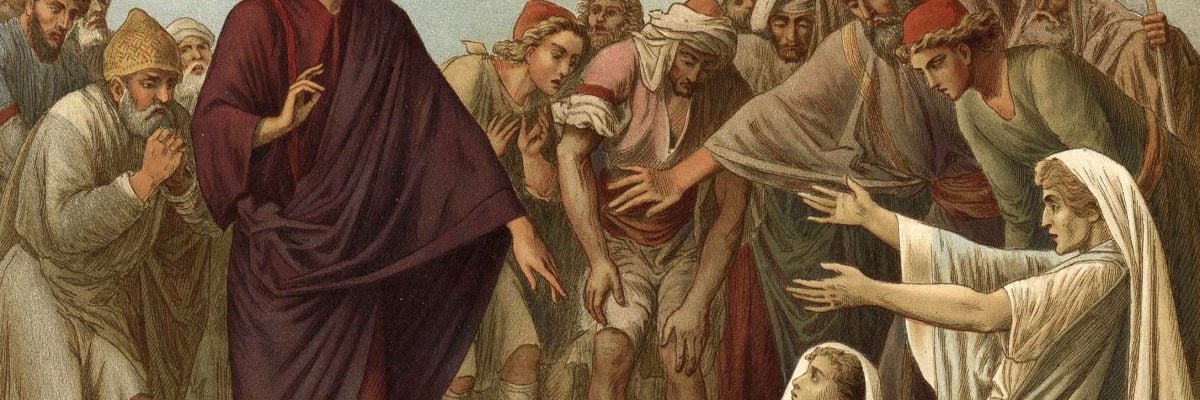
In the Bible, Jesus is said to have cast out demons, raised people from the dead, and healed the blind and deaf. But to many skeptics, such things sound like the stuff of legend, too fantastic to believe.
There are two ways to talk to skeptics about Jesus’ miracles: a general way and a specific way. The latter involves looking at each miracle individually, and it can get very involved. But let’s look in a general way at strategies that apply recognized historicity criteria to all the miracle accounts.
Our first strategy employs the embarrassment criterion. This refers to the idea that when embarrassing details are recorded about a sympathetic historical figure, they’re probably true— since the author would have no reason to make them up. One example of this is Mark’s account of the Pharisees’ accusation that Jesus performed miracles by the power of the devil:
“He is possessed by Be-elzebul, and by the prince of demons he casts out the demons” (3:22).
Why would Mark make up a story in which Jesus is accused of demonic possession when it has the potential to harm Jesus’ reputation, and thus undermine Mark’s purpose in writing his Gospel? If the embarrassment criterion suggests that the Pharisees’ accusation is historical, then Jesus’ contemporaries probably did see him as a man with remarkable powers who performed remarkable deeds. Why else would they make such a charge?
It’s not likely that Jesus’ toughest critics would acknowledge that he had supernatural powers unless it was common knowledge that he was exercising them.
A second strategy employs the criterion of dissimilarity. Applied to our case, it states that if a saying or deed attributed to Jesus is dissimilar to the Jewish traditions or to the broader historical milieu of the time, it is likely to be authentic.
The dissimilarities between Jesus’ miracles and ancient stories of wonder-workers, both Jewish and pagan, suggest to historians that the wonders Jesus performed were historical, not part of a local myth tradition. One unique characteristic is that Jesus performs miracles by his own authority:
- Mark 2:9: “Rise, take up your pallet and walk.”
- Mark 5:41: “Little girl, I say to you, arise.”
Notice that Jesus doesn’t say something like, “In the name of God, rise.” He simply gives the command, as if he possessed the power by his own nature.
In contrast, the Old Testament prophets Elijah and Elisha called on the power of God in order to raise the dead (1 Kings 17:17–22; 2 Kings 4:32–35). The first-century-B.C. Jewish wonder-worker Honi (Onias) is said to have brought down rain by praying to God while standing in the middle of a circle. Among the Greeks and Romans, similar methods of miracle-working were commonly reported—whether through magical formulas or paraphernalia, or prayers to the gods. But this is not how Jesus worked.
Another unique characteristic is that Jesus doesn’t perform miracles for the sake of showing off. Whereas pagan wonder-workers, such as Apollonius of Tyana (first century A.D.), sought to astonish and gain admiration, Jesus shied away from drawing attention to himself:
- He refused Herod’s request to show off his power (Luke 23:8–12).
- He got frustrated with the Pharisees’ constant requests for a sign (Mark 8:11–12).
- He turned down Satan’s request for him to show off his power (Matt. 4:5–7).
- He commanded the healed leper to remain silent (Mark 1:44).
Many people reflexively lump in Jesus’ miracles with other accounts of wonder-working in the ancient world. But the many dissimilarities between Jesus’ wondrous deeds and those of other ancient accounts—both Jewish and pagan— argue in favor of their historicity. What may at first glance seem like the stuff of legend does not have to keep reasonable people from considering the gospel.
Our third strategy highlights another dissimilarity: the stark contrast between Jesus’ miracles and the frivolous and exaggerated stories found in the fraudulent Gnostic Gospels that appeared in the early centuries of the Church.
We can use Mark’s account of the Resurrection as an example. It is simple and unembellished—he doesn’t even include the actual event of Jesus rising. If Mark was making this stuff up, don’t you think he would have described the actual moment when Jesus came back to life? Wouldn’t that have made it more interesting?
Mark’s restraint is glaringly different from the extraordinary details found in the apocryphal Gospel of Peter—giant angels, a talking cross, a voice from heaven, and Jesus coming out of the tomb as a gigantic figure whose head reaches to the clouds!
This editorial restraint can be noted elsewhere. Consider, for example, how the Gospel writers don’t portray Jesus as performing miracles to convert the hardened of heart. He doesn’t do so for those relatives that “take offense at him” in his hometown (Mark 6:4), the Pharisees who demanded he give a “sign from heaven” (Mark 8:11–13), or his enemies who tempted him to come down off the cross so that they might believe (Mark 8:31–32).
If the Gospel writers were fabricating events, it’s amazing that they didn’t take advantage of the opportunity to showcase Jesus’ power to convince his own skeptics—especially since they were trying to convince their own skeptics.
The Gospel accounts of Jesus’ miracles in his public ministry are as spare and restrained as the accounts of his birth, early life, and resurrection. Even though making the miracle stories more dramatic would have given them more appeal to potential converts, the Gospel writers did not give in to the temptation to exaggerate them.
“Legend” is something that escapes the methods of modern historical investigation. But the reports of Jesus’ miracles don’t fit that bill. The Gospel writers’ restraint, along with Jesus’ unique style and the testimony of his enemies, are all evidence for the historical reliability of the accounts of Jesus’ miracles.



